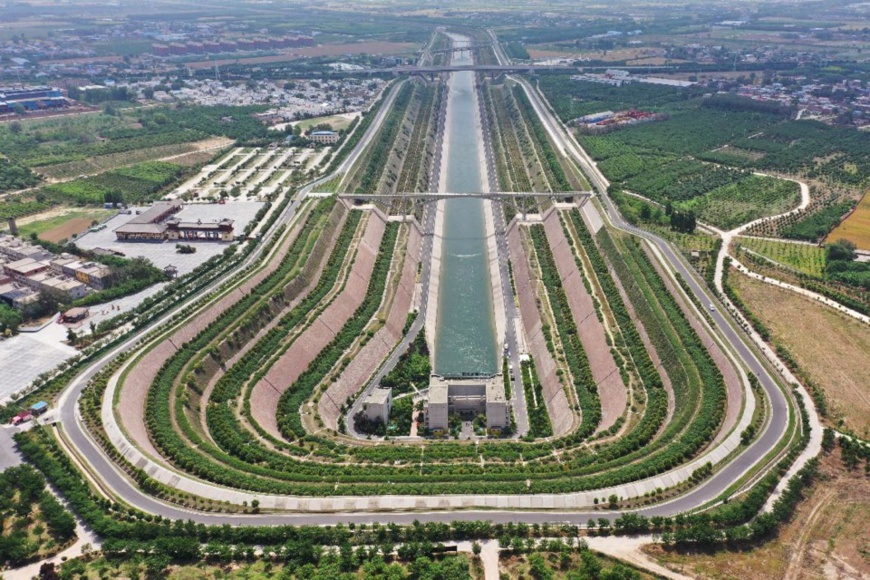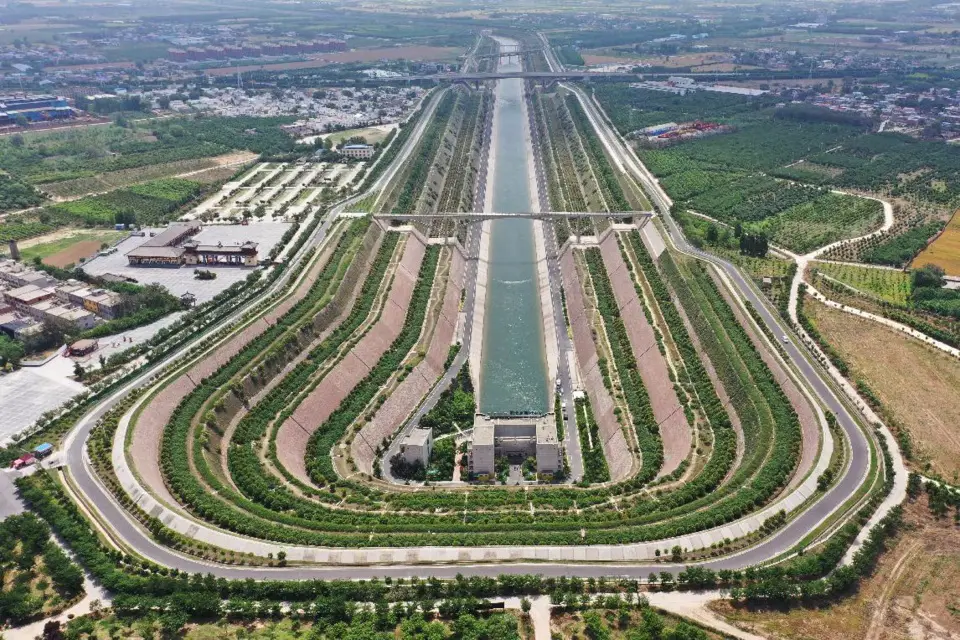By Wang Hao, Fan Haotian, People’s Daily

Photo taken in Xingyang county, Zhengzhou city, central China’s Henan province, shows a bird’s eye view of a tunnel project carrying water from the Yellow River’s southern bank to its northern bank. The tunnel is an important part of the middle route of China’s South-to-North Water Diversion Project, May 23, 2021. (Photo by He Wuchang/People’s Daily Online)
As of Dec. 12, which marked the seventh anniversary of the comprehensive operation of the first phase of the eastern and middle routes of China’s South-to-North Water Diversion Project, the project had transferred around 49.4 billion cubic meters of water from major rivers in southern China to the northern areas of the country and benefited 140 million people, suggested data released by China’s Ministry of Water Resources (MWR).
The amount of water transferred by the project over the past seven years is almost equivalent to the average annual runoff of the Yellow River, said the MWR.
After water pipes were laid and faucets installed, Shi Shurong, a resident in Xiaoshitang village, Suliuzhuang township, Xiajin county, Shandong province, has been able to get clean drinking water at his home.
“We now have sufficient water pressure and stable water flow. Finding safe drinking water is no longer a problem for us,” said Shi.
Thanks to the South-to-North Water Diversion Project, more and more people living along the routes of the project like Shi have bid farewell to the old days when they lacked access to clean drinking water.
Before the mega water diversion project was put into operation, the per capita water resources of the basins of the Yellow River, Huaihe River, and Haihe River was only 462 cubic meters, which was one fifth of the national average.
Water resources in China are distributed unevenly in terms of time and space, and the country has faced low per capita water resources, said Liu Changming, an academician of the Chinese Academy of Sciences (CAS) and a researcher with the Institute of Geographic Sciences and Natural Resources Research under the CAS, who believes that the water diversion project has struck a balance in water resources between the north and the south.
The project has been proven effective in alleviating water shortages in China’s northern regions, with the water transferred through the project becoming major water source of more than 40 large and medium-sized cities in northern China.
At present, more than 70 percent of the water supply in the urban area of Beijing is from the south part of China; water supply in the major urban districts of north China’s Tianjin municipality almost relies entirely on the water diversion project; and Shandong province has established a T-shaped water network because of the project.
So far, the water quality of the water diversion project has consistently reached required standards. All the water transferred via main lines of the first phase of the project’s eastern route has met required water quality standards and maintained a surface water quality of above Grade Ⅲ, while the surface water quality of the Danjiangkou Reservoir, the source of water transferred via the middle route of the water diversion project, as well as the middle route’s major lines has been maintained above Grade Ⅱ.
The water diversion project has also helped with continuous ecological water replenishment, bringing many dry river courses back to life.
Baiyangdian of north China’s Hebei province, which is dubbed the “Pearl of North China,” used to be long troubled by inadequate water quantity and poor water quality. Since 2018, the middle route of the South-to-North Water Diversion Project has continued to divert water to Baiyangdian for ecological restoration, which, in combination with water transferred from the Yellow River and local reservoirs, increased the water area of Baiyangdian from 171 square kilometers to 275 square kilometers.
“Since its operation, the first phase of the middle route has provided more than seven billion cubic meters of water for over 50 rivers in the north, comprehensively helping restore the ecological environment of rivers and lakes,” said Cheng Dehu, member of the leading Party members group of the construction and administration bureau of the middle route of the South-to-North Water Diversion Project, China South-to-North Water Diversion Corporation Ltd.
Ecological environment of rivers and lakes along the middle route of the water diversion project has been effectively improved because of water transferred through the route, which has yielded notable ecological benefits, said Cheng, who is also the chief engineer of the bureau.
Groundwater levels in northern China have gradually recovered thanks to the project. In 2020, the overall level of shallow groundwater in north China rose 0.23 meters from the previous year, the first rise after years of decline.
In addition, groundwater levels in Beijing’s plain areas have risen for six consecutive years. By the end of 2020, the overall level of shallow groundwater in Beijing rose 2.37 meters from the level at the end of 2014.
Water transferred from southern China has also played an important role in improving the navigation conditions of the Beijing-Hangzhou Grand Canal. So far, the section of the canal south of the Yellow River, stretching over a large area from Dongping Lake in Shandong province to the Yangtze River, has been opened to navigation, allowing ships with a load capacity between 1,000 tons and 2,000 tons to sail and increasing the handling capacity of ports along the canal by 13.5 million tons.
The water diversion project has also boosted the economic growth of main grain producing areas, energy bases, and major cities and townships along its routes.
Given that the water use per 10,000 yuan ($1,571) of GDP stood at 70.4 cubic meters on average between 2016 and 2019, 49.4 billion cubic meters of water transferred from southern China has effectively underpinned an increase of seven trillion yuan in GDP of the country’s drought-prone northern regions.
The South-to-North Water Diversion Project has realized connectivity and mutual complementarity between the Yangtze River with a tremendous amount of water and the water-scarce basins of the Yellow River, Huaihe River, and Haihe River, improved the comprehensive utilization of China’s water resources, and optimized the country’s structure of social and economic development, said an executive of China South-to-North Water Diversion Corporation Ltd.
The amount of water transferred by the project over the past seven years is almost equivalent to the average annual runoff of the Yellow River, said the MWR.
After water pipes were laid and faucets installed, Shi Shurong, a resident in Xiaoshitang village, Suliuzhuang township, Xiajin county, Shandong province, has been able to get clean drinking water at his home.
“We now have sufficient water pressure and stable water flow. Finding safe drinking water is no longer a problem for us,” said Shi.
Thanks to the South-to-North Water Diversion Project, more and more people living along the routes of the project like Shi have bid farewell to the old days when they lacked access to clean drinking water.
Before the mega water diversion project was put into operation, the per capita water resources of the basins of the Yellow River, Huaihe River, and Haihe River was only 462 cubic meters, which was one fifth of the national average.
Water resources in China are distributed unevenly in terms of time and space, and the country has faced low per capita water resources, said Liu Changming, an academician of the Chinese Academy of Sciences (CAS) and a researcher with the Institute of Geographic Sciences and Natural Resources Research under the CAS, who believes that the water diversion project has struck a balance in water resources between the north and the south.
The project has been proven effective in alleviating water shortages in China’s northern regions, with the water transferred through the project becoming major water source of more than 40 large and medium-sized cities in northern China.
At present, more than 70 percent of the water supply in the urban area of Beijing is from the south part of China; water supply in the major urban districts of north China’s Tianjin municipality almost relies entirely on the water diversion project; and Shandong province has established a T-shaped water network because of the project.
So far, the water quality of the water diversion project has consistently reached required standards. All the water transferred via main lines of the first phase of the project’s eastern route has met required water quality standards and maintained a surface water quality of above Grade Ⅲ, while the surface water quality of the Danjiangkou Reservoir, the source of water transferred via the middle route of the water diversion project, as well as the middle route’s major lines has been maintained above Grade Ⅱ.
The water diversion project has also helped with continuous ecological water replenishment, bringing many dry river courses back to life.
Baiyangdian of north China’s Hebei province, which is dubbed the “Pearl of North China,” used to be long troubled by inadequate water quantity and poor water quality. Since 2018, the middle route of the South-to-North Water Diversion Project has continued to divert water to Baiyangdian for ecological restoration, which, in combination with water transferred from the Yellow River and local reservoirs, increased the water area of Baiyangdian from 171 square kilometers to 275 square kilometers.
“Since its operation, the first phase of the middle route has provided more than seven billion cubic meters of water for over 50 rivers in the north, comprehensively helping restore the ecological environment of rivers and lakes,” said Cheng Dehu, member of the leading Party members group of the construction and administration bureau of the middle route of the South-to-North Water Diversion Project, China South-to-North Water Diversion Corporation Ltd.
Ecological environment of rivers and lakes along the middle route of the water diversion project has been effectively improved because of water transferred through the route, which has yielded notable ecological benefits, said Cheng, who is also the chief engineer of the bureau.
Groundwater levels in northern China have gradually recovered thanks to the project. In 2020, the overall level of shallow groundwater in north China rose 0.23 meters from the previous year, the first rise after years of decline.
In addition, groundwater levels in Beijing’s plain areas have risen for six consecutive years. By the end of 2020, the overall level of shallow groundwater in Beijing rose 2.37 meters from the level at the end of 2014.
Water transferred from southern China has also played an important role in improving the navigation conditions of the Beijing-Hangzhou Grand Canal. So far, the section of the canal south of the Yellow River, stretching over a large area from Dongping Lake in Shandong province to the Yangtze River, has been opened to navigation, allowing ships with a load capacity between 1,000 tons and 2,000 tons to sail and increasing the handling capacity of ports along the canal by 13.5 million tons.
The water diversion project has also boosted the economic growth of main grain producing areas, energy bases, and major cities and townships along its routes.
Given that the water use per 10,000 yuan ($1,571) of GDP stood at 70.4 cubic meters on average between 2016 and 2019, 49.4 billion cubic meters of water transferred from southern China has effectively underpinned an increase of seven trillion yuan in GDP of the country’s drought-prone northern regions.
The South-to-North Water Diversion Project has realized connectivity and mutual complementarity between the Yangtze River with a tremendous amount of water and the water-scarce basins of the Yellow River, Huaihe River, and Haihe River, improved the comprehensive utilization of China’s water resources, and optimized the country’s structure of social and economic development, said an executive of China South-to-North Water Diversion Corporation Ltd.
 Menu
Menu
 China’s South-to-North Water Diversion Project benefits 140 million people over past 7 years
China’s South-to-North Water Diversion Project benefits 140 million people over past 7 years
















